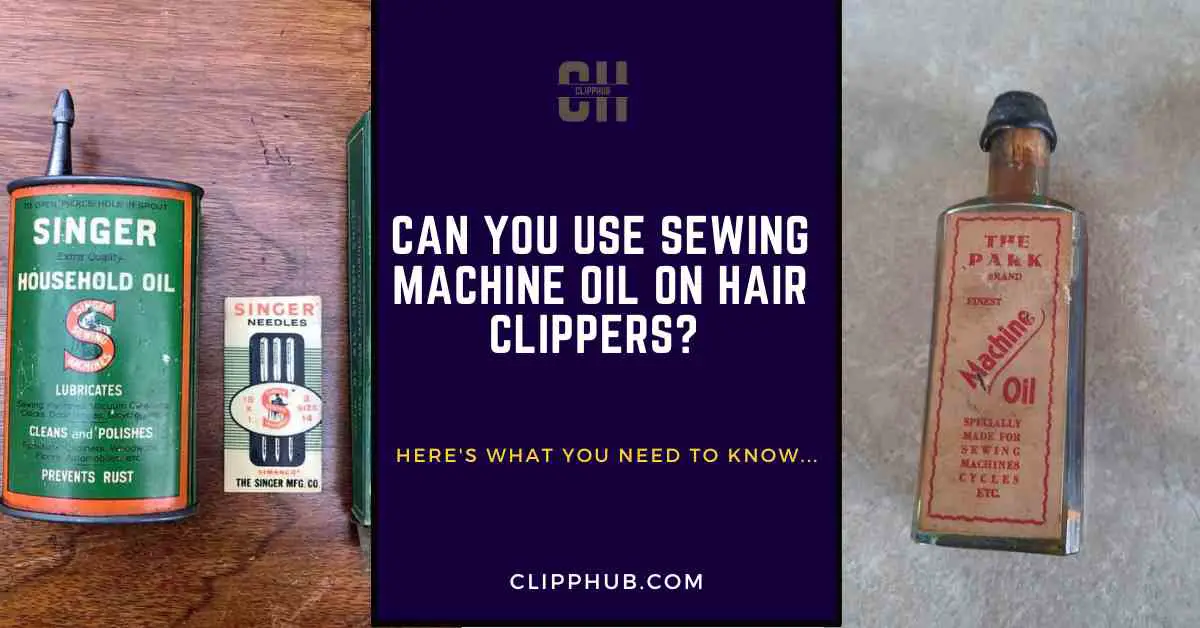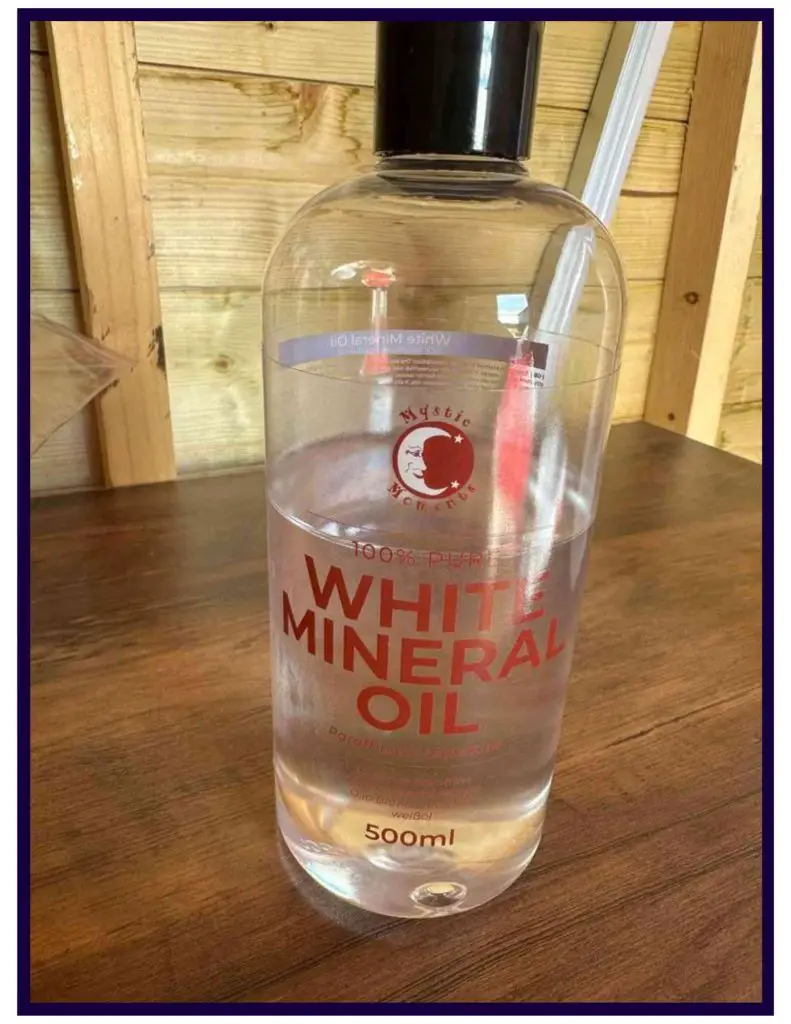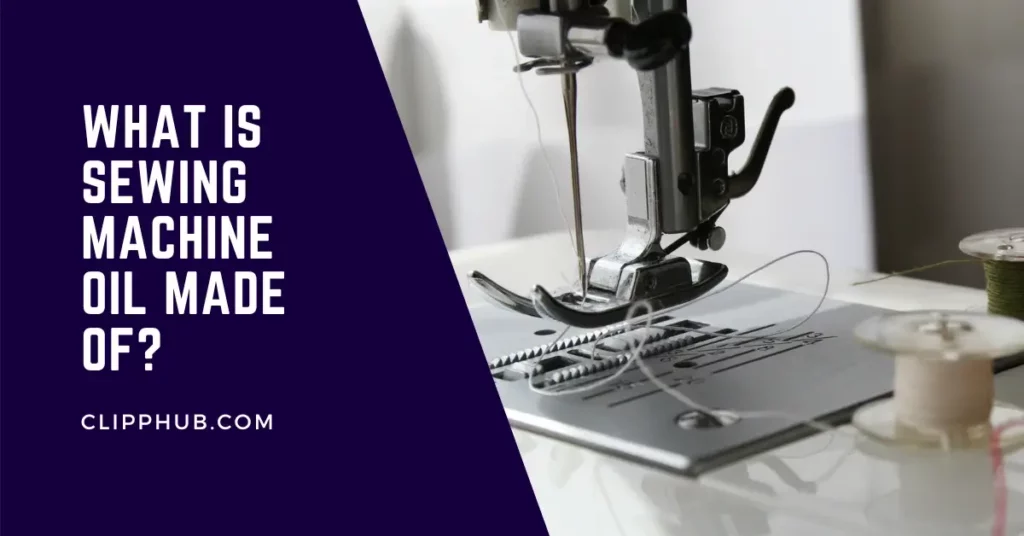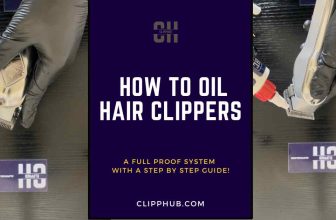
Sometimes we have a bottle of sewing oil lying around and hair clippers in need of oiling.
Surely it’s easy to put the two together right?
In this article, I’ll answer the question Can you use sewing machine oil on hair clippers? (I’ll also add some points you may not have thought of)
With that said let’s get into it.
Can I Use Sewing Machine Oil On Hair Clippers?
Quick answer:
However, depending on the manufacturer, sewing machine oils can have a lot of different petrochemicals that can build up inside your clippers, possibly damaging them.
What exactly are these petrochemicals?
Are there better alternatives to sewing oil?
All these questions are answered in the rest of this article.
What is a Sewing machine oil?
Machine sewing oil is a colorless/odorless oil that is typically used to lubricate the parts of a sewing machine.

While sewing oil is viscous(thick), it is still relatively light as it is mineral oil.
Being highly refined and light has its benefits as it means sewing oil does not easily become stuck in stuck in machines.
Machine oil is a versatile substance that can be used to lubricate a wide range of machines one of those are hair clippers.
What is Sewing Machine Oil Made Of?

Manufactured machine sewing is made from highly refined petroleum crude oil which ultimately makes it paraffin.
Liquid paraffin in mineral oil is a byproduct of crude oil distillation.
It is easy to say that sewing oil is just mineral oil, however, it all depends on the manufacturer of said “oil”.
Some sewing oils, on top of mineral oil, have petrochemical ingredients within their formula, this can make machine sewing oil more or less viscous than would be ideal for hair clippers.
Some make of sewing oil have a wide mix of petrochemical oils, these sewing oil ingredients can be:
- Jojoba oil
- Silicone oil
- ester oil
These are the variation of petrochemical oils that can be found within the machine oil and it varies between manufacturers.
What makes this a problem is that not all the ingredients used to make sewing oil are not listed on the ingredient list of the product.
This means different types of oil can be found in sewing oil and can have different effects on the machine it is being used.
So while the main component in machine sewing oil is refined petroleum oil, there are other oils within the formula. While it is only a small percentage, at times this can be a problem
I talk about this further on.
Sewing oil viscosity compared to other oils
Machine sewing oil viscosity varies between manufacturers. Overall sewing oil is a low-viscosity oil. It falls in the range that makes sewing oil in general, viable to use on hair clipper blades.
I cannot give a defined viscosity for sewing oil because manufacturers in this industry guard their ingredients.
Sewing oil is not a complex oil to remake, so any leverage manufacturers have for their products is well guarded, as if it’s able to get out it can be remade and sales would fall.
Nevertheless, sewing oil is still branded as ‘low viscosity.
The low viscosity rating for sewing means that is far thinner than other oils like vegetable and synthesized oils.
These oils are generally considered too thick to be used on hair clippers.
While some can be used like olive oil and coconut oil, they tend to be thicker than average and can cause problems with hair clippers.
Sewing oil has to be low-viscosity oil as it is to be used on machines and cannot be simply built up in machines after use. Vegetable oils were not made for this task and in general, so unsurprisingly, will not do as good of a job.
Sewing Machine Oil vs. Clipper Oil
Machine sewing oil and hair clipper oil are very similar, while they are low-viscosity oils, there are differences in their level of ‘thickness’.
Hair clipper oil is made to handle fast-moving blades and it is a very thin petroleum-based lubricant while machine oil was not made to handle these tasks so it is slightly thicker.
Negatives of using sewing oil on hair clippers
Machine sewing oil is similar to regular hair clipper oil and can be a good alternative to hair clipper oil.
However, while they do overlap, there is a difference that makes machine sewing oil potentially dangerous for your hair clippers.
Wahl hair clipper oil is made from 95% pure white mineral oil and the remaining ingredients are chemical ingredients made to balance the solution. These remaining ingredients do not affect the oil and are just there to stabilize the oil.
On the other hand, Clipper oil has other petrochemical oils as well as mineral oil, within its formula.
Also, with sewing oil manufacturers not disclosing the percentages of each ingredient within their product, it is advised to use an abundant amount of sewing oil on your hair clippers as extra oils can react with your hair clipper blades.
The possible petrochemical ingredients could be:
Jojoba oil:
Jojoba oil is not an ‘oil’ it is a liquid wax, this can be especially damaging to hair clippers as it can rapidly build up within hair clippers.
The build-up can work its way to the hair clipper motor and cause it to overheat or possibly break it, ultimately killing the longevity of your hair clippers.
Silicone oil:
Silicone oil is an oil that falls high on the viscosity index. This means that silicone oil can struggle to get around hair clipper blades to lubricate them efficiently.
Also, with the oil being so viscous, it may struggle to leave your hair clippers after use meaning that it can stay inside your hair clippers attracting hair and dirt.
This will eventually blunt your blades and leave your hair clippers performing poorly.
Ester oil:
While ester oil has good resistance to temperatures, it is an oil that has been made chemically.
Ester oils are synthetically made and were originally made of engine oil. Due to this it is a very thick oil and can be corrosive to fine metal.
Ester oil can wear away at your blades as well as cause build-up within your hair clippers if used constantly over a long period.
These added petrochemical ingredients in machine oil can have negative effects on your hair clippers.
While they do not make up the majority of the machine oil formula, they are still a hazard as you cannot truly know which type is in your hair clipper and how much.
Ultimately, it is a gamble to use machine oil on your hair clippers for a long period.
However, if you choose to do so as a stop-gap, this should not be a problem.
Then, Look to source actual hair clippers such as the ones suggested below:
I provide more detail about each choice in my best hair clipper oil review.
Unsure of how to apply the oil?
Don’t worry, I outline this below.
How to Apply Machine Oil to your Hair clipper
Oiling hair clippers is essential.
You should oil your hair clippers after you have cleaned and sterilized them to make the machine oil have the best effect possible.
Step 1:
Turn your hair clipper on
Step 2:
Apply three drops of machine oil at the point where the top cutting rail meets the clipper. Apply the oil across that front rail.
Step 3:
Apply a drop of machine oil to either side of the hair clipper
Step 4:
Turn the hair clippers off and turn them upside down to allow excess machine oil
Step 5:
Remove any excess machine oil from the blade using a cloth
How To Oil Hair Clippers – (The ULTIMATE Guide)
It is key to remove any remaining oil from your hair clippers after the oil has been applied.
Machine oils vary in the ingredients they have in them even though most are comprised of mineral oil.
The added extra petrochemical ingredients found in different types of machine oil can have damaging reactions with your hair clipper blades over a long period.
So removing any excess is a non-negotiable if you don’t want to run that risk.
Conclusion
You can do this article wondering, can you use sewing machine oil on hair clippers?
The answer is, yes you can( for the short term).
Sewing machine oil is mainly made up of mineral oil which is a good lubricant for hair clipper blades, however, the formula also contains petrochemical ingredients such as:
- Jojoba oil
- Ester oil
- Silicone oil
These oils can all negatively impact your hair clipper blades and you cannot truly know how much the petrochemical ingredients are in your machine oil formula. If you know, that is a benefit, however, if not it’s a gamble and something I would not recommend.
If you have found this article helpful please leave a comment about your experience with machine oil and check out other articles relating to this topic:
Sewing oil is a light colorless oil used to sew the moving parts of a sewing machine. The oil keeps the sewing machine running smoothly and reduces friction while protecting the machine from rust.
Sewing machine oil is cheap and easy to find, but it could clog or damage the clipper blades if it’s not clean or safe for the clipper. Hair clipper oil offers better protection against rust and corrosion.
















